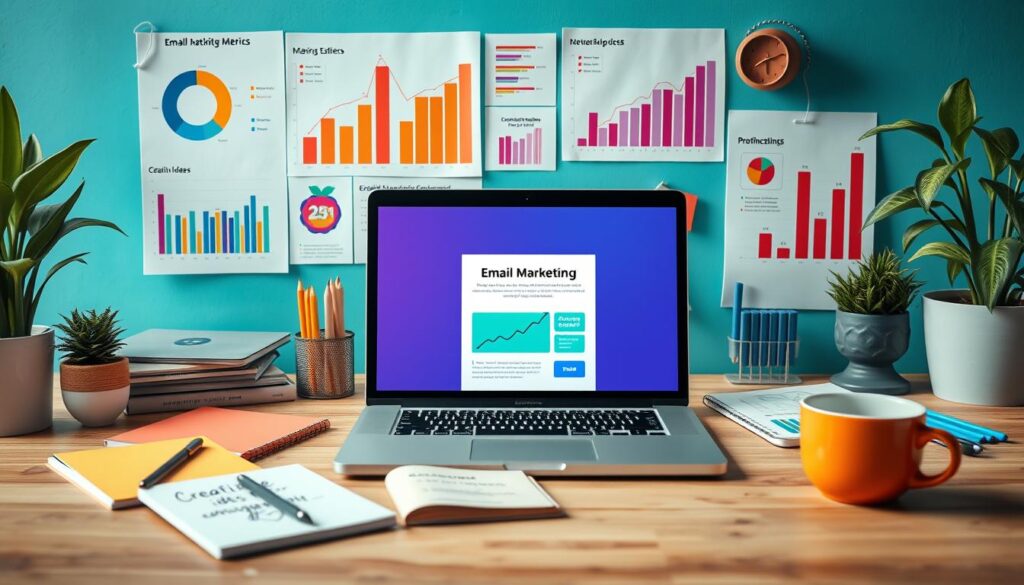Optimize Campaigns with E mail Marketing Template
Email marketing templates are key tools for boosting engagement and making campaigns more effective. They help me send out professional and attractive messages quickly. This not only saves time but also boosts my email marketing success.
As I explore this topic, I’ll show how these templates are crucial for optimizing campaigns. They help me connect better with my audience.

Key Takeaways
- Email marketing templates simplify the campaign creation process.
- They enhance overall branding and consistency.
- Well-designed templates drive higher engagement rates.
- Templates can be customized for specific audience segments.
- Utilizing templates saves time and effort in crafting emails.
- Effective email marketing relies on good design principles.
Understanding the Basics of Email Marketing
Email marketing is a key tool for businesses to connect with their audience. It involves sending messages through email to build relationships with customers and prospects. Knowing about email marketing means understanding its purpose—like driving sales, boosting engagement, and building loyalty.
Email marketing creates a direct connection with subscribers. Unlike social media, where people can be scattered, email marketing lets you talk directly to them. It shows how interacting with subscribers can lead to more sales.
- List Building: Creating a subscriber list is a basic step in email marketing. A good list helps send messages to the right people.
- Target Audience: Knowing your audience well is key to successful email marketing.
- Engagement Strategies: It’s important to make emails engaging. Use personalized content, catchy subject lines, and clear calls to action to keep people interested.
Building a good list and targeting the right audience are crucial. With the right strategies, businesses can really connect with their subscribers. Leaders like Mailchimp and Aweber share valuable tips, showing how to meet the needs of today’s customers.
| Key Concept | Description |
|---|---|
| Email Marketing Definition | A digital marketing strategy used to promote products or services through email communication. |
| Goals | Drive sales, increase engagement, build customer loyalty. |
| List Building | Creating a targeted list of subscribers based on preferences and behaviors. |
| Engagement | Fostering interaction with customers through personalized and relevant content. |
| Targeting | Identifying and reaching the right audience for effective campaigns. |
Benefits of Using an Email Marketing Template
Email marketing templates are a game-changer. They save a lot of time and make campaigns more efficient. With pre-designed layouts, I can create engaging emails fast, without starting over every time. This lets me focus more on the message and less on design.
Another big plus is keeping your brand consistent. Templates ensure your colors, fonts, and logos match your brand. This consistency helps build a strong brand identity and loyal audience.
Templates are also great for making quick changes in campaigns. I can easily tweak elements for different promotions or announcements. This keeps my emails looking professional and on-brand.
Studies show templates can boost engagement. Businesses using templates often see better click-through and conversion rates. In my own campaigns, the organized and attractive templates lead to more interaction with the content.

- Time-saving: Allows more focus on message creation.
- Brand consistency: Strengthens brand recognition.
- Flexible updates: Streamlines modifications for different campaigns.
- Increased engagement: Boosts interaction and conversion rates.
| Benefit | Description |
|---|---|
| Time Savings | Quickly create emails without starting from scratch. |
| Consistency | Ensures branding stays uniform across campaigns. |
| Flexibility | Easy to adapt for various promotions or messages. |
| Engagement | Templates can increase click-through and conversion rates. |
Email Marketing Template: Key Features
Choosing the right email marketing template is crucial. I look for key features that ensure a successful campaign. These elements are vital for engagement and effectiveness.
Customization Options
Customizing email templates is key to matching my brand. A good template lets me change colors, fonts, and layouts. This makes my emails more appealing to my audience.
I like templates with easy design tools or drag-and-drop features. They make creating emails simple. Plus, personalizing content for different groups makes my emails more relevant and engaging.
Responsive Designs
Responsive email templates are a must today. They work well on all devices, like smartphones and tablets. Since over 50% of emails are opened on mobiles, it’s essential.
I make sure my templates look great on any device. This ensures my audience stays engaged, no matter how they check their emails.

Email Campaign Template: How to Get Started
Starting with email templates makes launching an email marketing campaign easier. Choosing the right template is key to success. Here are steps to help you get started.
- Choose the Right Template: Pick a template that fits your brand and goals. Look for ones that are flexible and suit your audience.
- Customization: After picking a template, make it your own. Add your logo, change colors, and adjust content to keep your brand consistent.
- Integrate with Software: Make sure your template works with email marketing tools like Aweber or GetResponse. This makes sending emails easier and tracks how well they do.
Studies show that using structured templates can increase engagement and clicks. Adding stats from past campaigns can also make your emails more convincing.

Email Marketing Design Principles
Creating great email marketing campaigns needs focus on key principles. The right mix of design can really boost your email’s impact. Color theory and layout are crucial for grabbing attention and keeping it.
Color Theory and Branding
Colors in emails are key for connecting with your audience. They stir emotions and shape how people see your brand. Pick colors that match your brand for better recognition and trust.
- Brand Consistency: Stick to your brand’s colors for a unified message.
- Emotional Impact: Colors like blue for trust and red for urgency can influence feelings.
- Target Audience: Choose colors that appeal to your subscribers’ tastes.
Layout and Formatting Techniques
Good email layout is crucial for keeping readers interested. A clear, easy-to-read design encourages action. Here are some tips:
- Hierarchy: Use headings and subheadings to guide the reader.
- White Space: Add enough white space to avoid clutter and improve reading.
- Imagery: Use images that support the text without overwhelming it.
- Responsive Design: Make sure your emails look good on all devices.

| Color | Emotional Response | Usage in Branding |
|---|---|---|
| Blue | Trust and Calm | Finance, Technology |
| Red | Urgency and Energy | Food, Clearance Sales |
| Green | Growth and Tranquility | Environment, Health |
| Yellow | Optimism and Happiness | Retail, Kids’ Products |
By using color theory and layout techniques, I can make visually appealing campaigns. Each part helps engage subscribers and boost brand visibility.
Email Marketing Best Practices for Engaging Recipients
To excel in email marketing, I follow best practices that build real connections. Segmenting email lists by demographics or past actions is key. This way, I can make content that really speaks to each group.
Personalization is a big deal for better engagement. Saying hello by name or suggesting products based on past buys makes a big difference. Using these tactics can really boost how much people interact with emails.
Creating catchy subject lines is also crucial. A good subject line can get more people to open the email. It grabs their interest and makes them want to see what’s inside.
Testing is essential too. I often test different parts of my emails to see what works best. By following these practices, my campaigns have seen real improvements.

Using an Email Template Generator for Efficiency
In today’s fast-paced world, using an email template generator boosts my email marketing efficiency. These tools make creating email templates easy and fast. They don’t require coding knowledge. Mailchimp’s template builder and Canva’s email design tool are great examples, offering easy-to-use interfaces.
These generators have a drag-and-drop feature. This makes adding images, text, and other elements simple. It saves time and makes emails look better. I can focus on the content, not the technical details.
Many email template generators also offer analytics. These tools help me track my campaign’s performance. This data is crucial for improving my email marketing strategies.

| Tool | Customization Options | User Experience | Analytics Features |
|---|---|---|---|
| Mailchimp | Extensive | User-friendly | Yes |
| Canva | Highly customizable | Very intuitive | Limited |
| Aweber | Good | Easy to use | Yes |
Using an email template generator changes how I create email templates. It lets me focus on making messages compelling. This improves my email marketing strategy.
Email Template Examples to Inspire Your Campaigns
Looking at different email templates can really spark your creativity. I’ve studied many successful designs from big brands. They know how to grab their audience’s attention. Here are some examples that stand out:
- Envato: Their emails are full of bright visuals and clear calls to action. This makes the message easy to understand and fun to read.
- Airbnb: They use personal info to make each email special. It feels like they’re talking just to you.
- H&M: They mix seasonal themes with amazing visuals. It makes you want to check out their new stuff.
These brands show us what makes a great email. They use colors, fonts, and layout in a way that makes their brand pop. By looking at these examples, I can pick up tips for my own emails.

- Keep it consistent: Use colors and fonts that match your brand.
- Make it work on all devices: Your email should look good on phones, tablets, and computers.
- Have a strong call-to-action: Tell your readers what you want them to do next.
Getting inspired by these email templates helps me make my marketing better. It improves how people interact with my emails and how often they buy from me.
Conclusion
As I conclude this look at email marketing templates, it’s clear they’re key to better campaigns. Understanding design and best practices boosts audience engagement. Customizable and responsive designs create messages that hit home with subscribers.
Reflecting on email campaigns, the right tools are essential. They make the process easier and improve our strategies. Whether it’s a newsletter or a promotional email, the right template is crucial. It helps us connect with our audience more deeply.
I urge you to start by finding templates that match your brand. Improving your email strategies today can lead to more conversions and loyal customers tomorrow. The right template is just the start of a successful journey with your subscribers.
FAQ
What is an email marketing template?
An email marketing template is a pre-made layout for creating and sending emails. It helps keep my brand consistent and makes email marketing easier.
How do I customize an email marketing template?
To customize a template, I change colors, fonts, and images to match my brand. Most tools have easy-to-use interfaces for this.
Are email marketing templates responsive?
Yes, responsive templates adjust to any device. This means my emails look good on any screen, helping to engage more people.
What are the best practices for using email marketing templates?
Best practices include segmenting my list and personalizing content. I also make sure my templates are attractive. These steps can boost open rates and engagement.
Can I find examples of effective email templates?
Definitely! There are many examples online that show successful designs. Looking at these can inspire and teach me about effective strategies.
What tools can I use to create email marketing templates?
Tools like Mailchimp’s template builder and Canvas email design tool are great. They make creating beautiful templates easy and help improve my campaigns.
How do email marketing templates help improve campaign efficiency?
Templates save time by making design quicker. This lets me focus on creating engaging content for my audience.